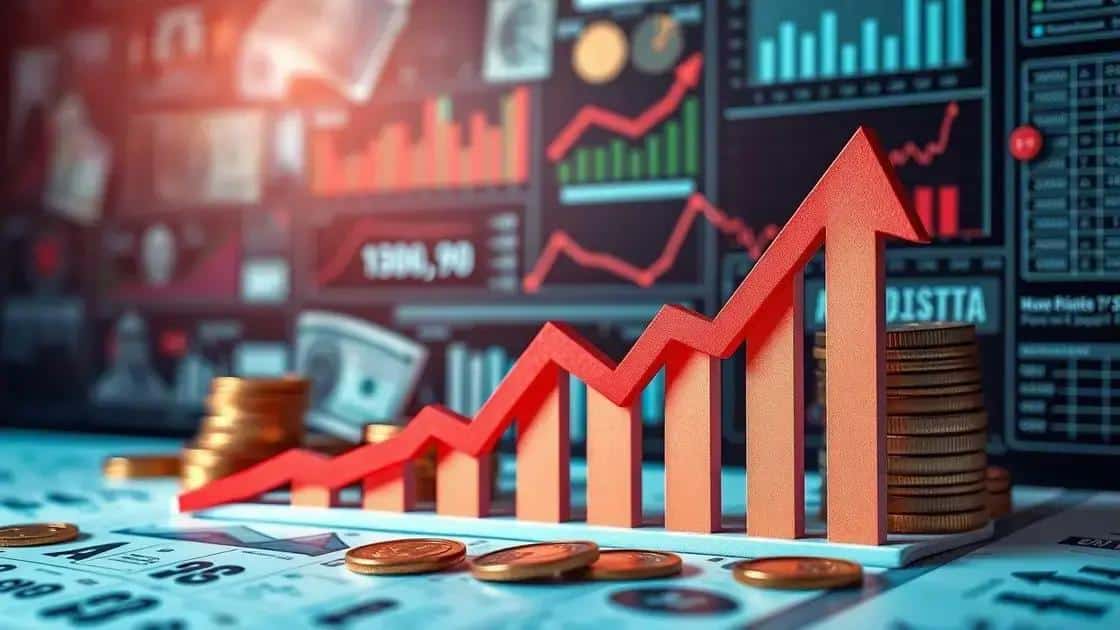Major Federal Reserve interest rate changes and their impacts

Major Federal Reserve interest rate changes directly impact consumer spending, investment strategies, and overall market behavior, with rising rates discouraging borrowing while encouraging saving due to higher returns.
Major Federal Reserve interest rate changes significantly influence the financial landscape. Ever wondered how these adjustments can impact your wallet? Join me as we unravel the effects of these crucial changes.
Understanding the Federal Reserve’s role
The Federal Reserve is a vital part of the U.S. economy. Understanding its role helps to clarify how it influences financial stability and growth.
It operates mainly through monetary policy, making adjustments to interest rates to influence economic activity. This can affect inflation, employment rates, and overall economic growth. The goal is to promote maximum employment and stable prices.
Key Functions of the Federal Reserve
There are several essential functions of the Federal Reserve:
- Setting interest rates through monetary policy.
- Supervising and regulating banks.
- Maintaining financial stability.
The Federal Reserve’s decisions can dramatically impact everyday life. For instance, when interest rates rise, borrowing costs increase, making loans for cars or homes more expensive. Conversely, lower rates can boost spending and investment.
Impact on the Economy
The Federal Reserve plays a crucial role during financial crises. By lowering interest rates or implementing quantitative easing, it can inject liquidity into the economy, helping it recover from downturns.
Monitoring these changes is essential. Individuals and businesses should stay informed about Federal Reserve decisions as they affect financial behavior. Keeping an eye on inflation expectations can also help consumers make informed decisions.
In summary, grasping the Federal Reserve’s role can provide valuable insight into economic trends and personal finance. Understanding how its policies affect interest rates can help you plan better for the future.
Historical interest rate changes and outcomes
Understanding historical interest rate changes is essential to grasp how the economy reacts during different periods. These changes can reshape financial habits and the broader economic landscape.
Throughout history, there have been significant shifts in interest rates that have impacted consumers and businesses alike. For instance, during the 1980s, the Federal Reserve raised rates to combat severe inflation, leading to higher borrowing costs. This resulted in a slowdown in consumer spending, influencing the overall economy.
Key Historical Changes
Several landmark changes in interest rates have marked economic trends:
- In the early 1990s, rates were lowered to stimulate growth.
- During the 2008 financial crisis, a series of rate cuts helped stabilize markets.
- In 2020, rates were again lowered to mitigate the impact of the COVID-19 pandemic.
These adjustments illustrate the relationship between interest rates and economic health. When rates rise, borrowing becomes costlier, leading to reductions in spending and investment. Conversely, lower rates often spur economic growth by encouraging loans and spending.
Setbacks and Successes
Historically, interest rate changes have yielded mixed outcomes. While some rate hikes aimed to bring inflation under control succeeded, they often led to recession or reduced economic activity. For example, the aggressive rate hikes in the late 1970s resulted in a period known as the “stagflation” era, characterized by high inflation and unemployment.
On the other hand, effective rate cuts can invigorate economic activity. The dramatic cuts during the 2008 crisis and again in 2020 were designed to encourage borrowing and spending, ultimately helping to recover the economy from downturns.
Current trends in interest rates

Current trends in interest rates play a crucial role in shaping the economic landscape. Monitoring these trends helps individuals and businesses make informed financial decisions. Interest rates can fluctuate due to various factors, including economic growth, inflation, and central bank policies.
Recently, we have seen a trend of rising interest rates as central banks respond to inflation concerns. As prices for goods and services increase, raising interest rates can help control inflation by making borrowing more expensive.
Key Factors Influencing Current Trends
Several factors are presently influencing interest rates:
- Inflation rates: As inflation rises, central banks often increase interest rates to stabilize the economy.
- Economic growth: Strong economic growth can lead to higher rates as consumer demand increases.
- Employment rates: A tight labor market can prompt rate hikes as businesses compete for workers.
As these factors shift, interest rates may continue to fluctuate. It’s essential to stay informed about these changes, as they can significantly impact everything from mortgage rates to credit card interest rates.
Impact on Consumers and Businesses
The recent increases in interest rates can impact consumers directly. For example, when rates are higher, the costs of loans increase. This can make purchasing homes, cars, or financing education more expensive. Consumers may think twice before taking out loans in a higher-rate environment.
On the business side, companies may face increased borrowing costs, which could affect expansion plans or investment in new projects. Businesses often adjust their strategies based on interest rates, seeking to minimize costs and maximize opportunities in changing markets.
How interest rates affect consumer behavior
Interest rates play a significant role in shaping consumer behavior. When rates change, it affects how people spend, save, and borrow money. Understanding this connection can help consumers make informed financial decisions.
When interest rates are low, consumers are often more encouraged to borrow money. This can lead to increases in spending on big-ticket items like homes and cars. People may feel more confident taking out loans when borrowing costs are lower. This means that low interest rates can boost consumer confidence and overall spending in the economy.
Impulse to Borrow
In a low-rate environment, consumers tend to:
- Purchase homes and invest in real estate, as mortgage rates are cheaper.
- Buy cars and appliances with low-interest financing offers.
- Utilize credit cards for purchases since the cost of borrowing is reduced.
However, when interest rates rise, borrowing becomes more expensive. Higher rates can discourage consumers from taking out loans. This shift often results in consumers being more cautious with their spending. They might delay significant purchases or rely on savings instead of credit.
Impact on Saving Behavior
Changes in interest rates also influence how consumers save money. When rates go up, savings accounts and CDs may offer better returns. This can encourage people to save more, as they receive higher interest on their deposits. Conversely, when rates are low, the incentive to save diminishes because the returns are lower.
Overall, it’s essential for consumers to stay informed about interest rate trends. Knowing how rates impact behavior can help individuals plan their finances better, whether it involves taking out a loan or saving for the future. Understanding the relationship between interest rates and consumer habits can lead to smarter financial decisions.
Implications for investors and markets
The implications of interest rate changes for investors and markets are profound. Understanding these effects can help investors make informed decisions that align with their financial goals. As interest rates fluctuate, they can influence investment strategies, asset valuations, and overall market conditions.
When interest rates rise, borrowing becomes more expensive. This can lead to decreased spending by both consumers and businesses. Investors need to be mindful of how higher rates may impact corporate profits, often resulting in lower stock prices. Growth stocks, especially those in technology or emerging sectors, can take a harder hit as their potential earnings may be discounted more heavily in a higher rate environment.
Investment Strategy Adjustments
In a rising rate environment, investors might consider:
- Shifting funds into bonds that offer better yields as rates increase.
- Investing in defensive sectors, such as utilities and consumer staples, which tend to perform better when growth slows.
- Looking for international investments that may be less sensitive to U.S. rate changes.
Conversely, when interest rates are low, borrowing costs decrease, encouraging consumer spending and business investments. This can lead to increased economic activity, benefiting stocks overall. Investors might focus on growth companies that capitalize on the favorable borrowing conditions and expanding markets.
Market Sentiments and Trends
Market sentiment often shifts based on anticipated interest rate changes. If investors believe rates will rise, they might sell off high-risk assets in favor of safer investments. This shift can result in increased volatility in stock markets. Bonds usually become more appealing as investors seek more stable returns amidst uncertainty.
Understanding the relationship between interest rates, market dynamics, and investor behavior can guide investment decisions. Keeping an eye on central bank policies is essential—it helps investors anticipate changes that could significantly impact their portfolios.
FAQ – Frequently Asked Questions about Interest Rates and Their Impact
How do interest rate changes affect consumer spending?
When interest rates are low, borrowing costs decrease, encouraging consumers to spend more on loans for homes, cars, and other major purchases.
What happens to investments when interest rates rise?
Higher interest rates can lead to decreased market confidence, often resulting in lower stock prices and a shift in investor strategies towards safer assets.
How do rising interest rates influence saving behavior?
When interest rates increase, savings accounts and other fixed-income investments typically offer better returns, encouraging consumers to save more.
Why is it important for investors to monitor interest rate trends?
Monitoring interest rate trends helps investors anticipate economic changes, adjust their portfolios accordingly, and seize opportunities in various market conditions.






